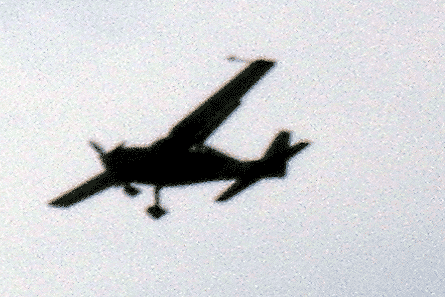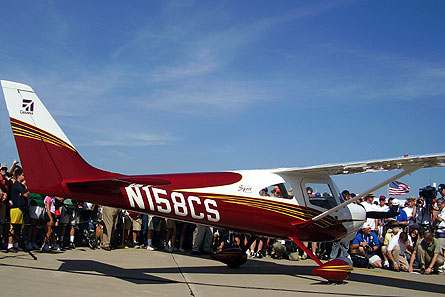By Jeffrey Decker in Oshkosh, Wisconsin
Cessna unveiled two new aircraft today, with a fly-past of a brand new piston replacement adding to the planned launch of the company's entry into the light sportsplane categoy.
The crowd gathered at in Oshkosh, Wisconsin at the US Experimental Aircraft Association's annual Air Venture air show to see the debut of Cessna's first Light Sport Aircraft (LSA) was also treated to the announcement that the company has committed to produce a second generation of single-engine aircraft, the Next Generation Piston (NGP) aircraft project (pictured below in silhouette).

"We've been looking at a range of possibilities, features, materials, technologies and processes that will result in an aircraft family that is responsive to the market needs and preferences of our customers and will be a strong competitor with the latest single engine piston aircraft on the market now and in the future," says Cessna chairman and chief executive Jack Pelton.
There is no timeframe to release the new aircraft, but Pelton said it would be in the "not too distant future." The NGP has been flying since 23 June, he revealed. "It is fulfilling all of our expectations, and then some," he said.
The announcement rivaled the debut of the LSA aircraft (pictured below). The high-winged plane is currently known only as the "Cessna Light Sport Proof of Concept Aircraft." The two-seated tricycle gear craft has no engine or interior. It is designed to reach the maximum LSA speed of 120kt (220km/h) "It is powered by a 120hp [90kW] Rotax 912 engine," explained Pelton. It has a wingspan of 9m (30ft) and a maximum cabin width of 122cm (48in).
 |
|---|
| © Jeffrey Decker |
The concept LSA aircraft incorporates dual control sticks, upward-opening doors and toe brakes. "The construction is primarily of aluminium but we've incorporated some composite parts," he says. The first flight of this aircraft is scheduled for later this year. No price has been determined.
"We want to make sure that this aircraft is what the market wants," stressed Pelton, and he invited the public to give its opinions through surveys at the show. Cessna will decide whether to enter the market in the first quarter of 2007, he said.
"It appears to be the logical extension to our product line," he added, "But most importantly, we believe that the Light Sport Aircraft may be the key to stimulating new pilots, restarts, re-energising the industry and improving the pipeline of human talent that is so important to this industry."
Dozens of Cessna engineers and officials were on hand in polo shirts branded Cessna Sport Aircraft, in a hint that the company may be prepared to permanently enter the market.
Light Aircraft Manufacturing Association President Tom Gunnarson joined a chorus of support for the possible entrance of Cessna into the young LSA market. He believes Cessna's announcement helps support the new industry consensus standards for LSA. The US Federal Aviation Administration went into new territory by letting manufacturers play a greater role in new aircraft approval, he said, and the manufacturers who supported the LSA concept for more than 15 years just got a confidence boost. "It certainly brings them some legitimacy because now they are in the same arena directly with a very well-known and well-thought-of company," he states.
Were Cessna to stake a claim in the young market they would be a fierce competitor. "With anything like this," Gunnarson says, "After a while it's going to whittle down to those who not only have a good product but have a backup and an infrastructure to really promote their product and services."
Source: Flight International
















